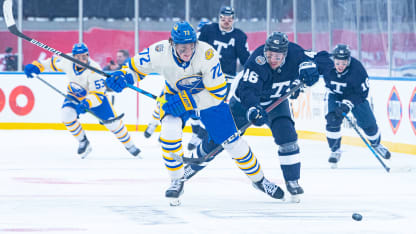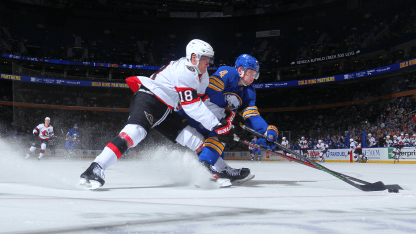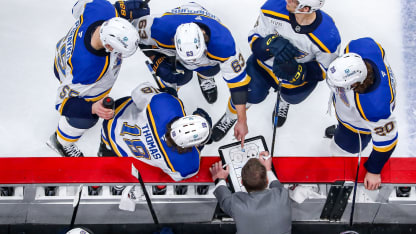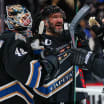The Coaches Room is a regular feature throughout the 2024-25 season by former NHL coaches and assistants who turn their critical gaze to the game and explain it through the lens of a teacher.
In this edition, Craig Johnson, a former assistant with the Anaheim Ducks and Ontario of the American Hockey League, and development coach with the Los Angeles Kings, writes about how coaches utilize analytics.
Analytics have become a valuable tool for coaches in identifying areas where their teams and individual players are playing well or need improvement. Analytics are an important part of the game now and you need to embrace them. You can't rely only on your eyes. You need to also watch the video and put the video to the numbers.
When looking at analytics, there are so many numbers available, so you need to sort through them and find what's important to your value system as a coach and what's important to your value system as a team.
When you find that, then you can use numbers that will help you.
When I was coaching, one of the areas we always looked at on the offensive end was shots from the slot and passes to the slot. The teams that were putting the pucks there or the pucks that were going into dangerous areas, the more the puck would go there, the more shots you were getting.
You can also look at the rush and the forecheck: how often you're getting rush shots, how often your forecheck is creating shots, too. Those were important numbers to me and, obviously, limiting scoring chances against and shot attempts from the slot is important as well.
Of course, there is a balance between what you see behind the bench and what the numbers say. As a coach, you need to look at it through your eyes and then you need to get a feel of the game. That's not spitting out any numbers. It's the feel of the game.
Then, when you're done with that, you're going to look at video and you're going to break it down, basically what you felt should show up in the analytics, but sometimes you look at the numbers and you notice something you didn't see or feel.
Maybe you're giving up too many scoring chances from the slot, so then you look at how you can defend a little bit better in that area. Or if you're not generating enough scoring chances from the slot, the puck isn't getting into the slot enough or you're not making enough pass attempts into slot, you look at how you can get the puck into that area more.
Do you have to shoot more, create more volume to get that puck into the slot area where you can get rebounds? Or maybe it's just a simple pass up or getting more shots through from the point to get that second shot on the rebound.
When I was coaching in Ontario of the American Hockey League and I ran the power play, I would look at the internal numbers we had through the Los Angeles Kings and usually break it down into usually five-game segments. I would go through a nine or 10-game segment, too, and I would look at where we were compared to the other teams.
I would look at our controlled zone entry success, how often we were getting passes to the slot and how often we were getting shots on net from the slot. Those were really important numbers to me, and then I thought the goals would kind of take care of themselves.
I would look at the numbers and I'd be like, "We didn't get enough slot chances. Well, how do we get the puck in there?" Maybe it's got to go down and in a little bit more. Maybe we're shooting the pucks and we're not in good rebound position.
Then, obviously, there's face-off winning percentage. We didn't have a great one that season, but we ended with the No. 1 power play in the history of the AHL at 27.48 percent in 2021-22.
My last year as a player in the NHL was 2004 and analytics weren't a big part of the game, yet. There was plus-minus and not much more. When I played for the Kings, coach Andy Murray created a system where he used hits, blocked shots, takeaways, giveaways and shots on net, and added it all up to create a number. Each player would be rated by that number.
When I was an assistant with the Anaheim Ducks last season, we had also a system for rating the players. The coaches would break down the video to give the players a rating, so the players received some form of feedback every game.
Feedback is important because maybe the players see it and say, "I need to create a little more, create positive chances, so I'm on the plus side of that." Or if we're not getting enough chances, why? Maybe you're defending too much, so you're not going to be able to create enough offensively because you're a little bit tired.
So, there's different ways you can use those numbers to tweak things, maybe to be a little more aggressive, double the puck more, whatever it is so you can get the puck and have it in the offensive zone more. Players are smart and see the value of analytics as well. Sometimes the numbers can help them see what they're doing well, and it can give them confidence.
I remember working with a player in Ontario who is now in the NHL, and he wasn't scoring as much as he wanted. When we looked at his numbers, he was in the top of the AHL as far as generating plays, but the puck just wasn't going in. Those numbers gave him a little confidence like, "Hey, I am generating chances, and my numbers aren't there, but eventually they're going to come around." So, it can be beneficial for a player.
Similarly, sometimes players on the third or fourth lines are looking for ways that they can feel productive. And you might see players getting their sticks on pucks quite a bit. Then, you look at the analytics of it and you might see he's one of the better players in the NHL at disrupting plays, so you show the players that and it can add confidence to their game that they're contributing to the cause even if they're not scoring as much.
Conversely, a player might wonder, "Why am I not producing?" And you might say, "You're not bringing pucks to the front of the net. You're not getting shots from the slot area and maybe you need to get to the net more." Or maybe you're not getting your stick on the puck or you're not disrupting anything, so you don't have the puck as much.
The more information players have to help answer their questions, the more trust you can build in their development.



















